Investment Success: Role of Project Management & Benefits Management
VerifiedAdded on 2020/09/09
|16
|5551
|66
Literature Review
AI Summary
This literature review explores the relationship between project management (PM) and benefits management (BM) practices and their impact on the success of investments. It discusses theoretical underpinnings, including project success metrics, benefits management frameworks, and project benefits governance. The review examines the importance of aligning project management and benefits management to maximize organizational value and investment returns. It also addresses the significance of project governance, stakeholder management, and the role of key performance indicators (KPIs) in measuring project success. Furthermore, the review highlights the need for active benefits management (ABM) and emphasizes the importance of continuous monitoring and adaptation to ensure that projects deliver the expected benefits and contribute to overall investment success. The study concludes by emphasizing the importance of a well-defined governance framework and a collaborative approach between project managers and benefits owners to achieve optimal project outcomes.
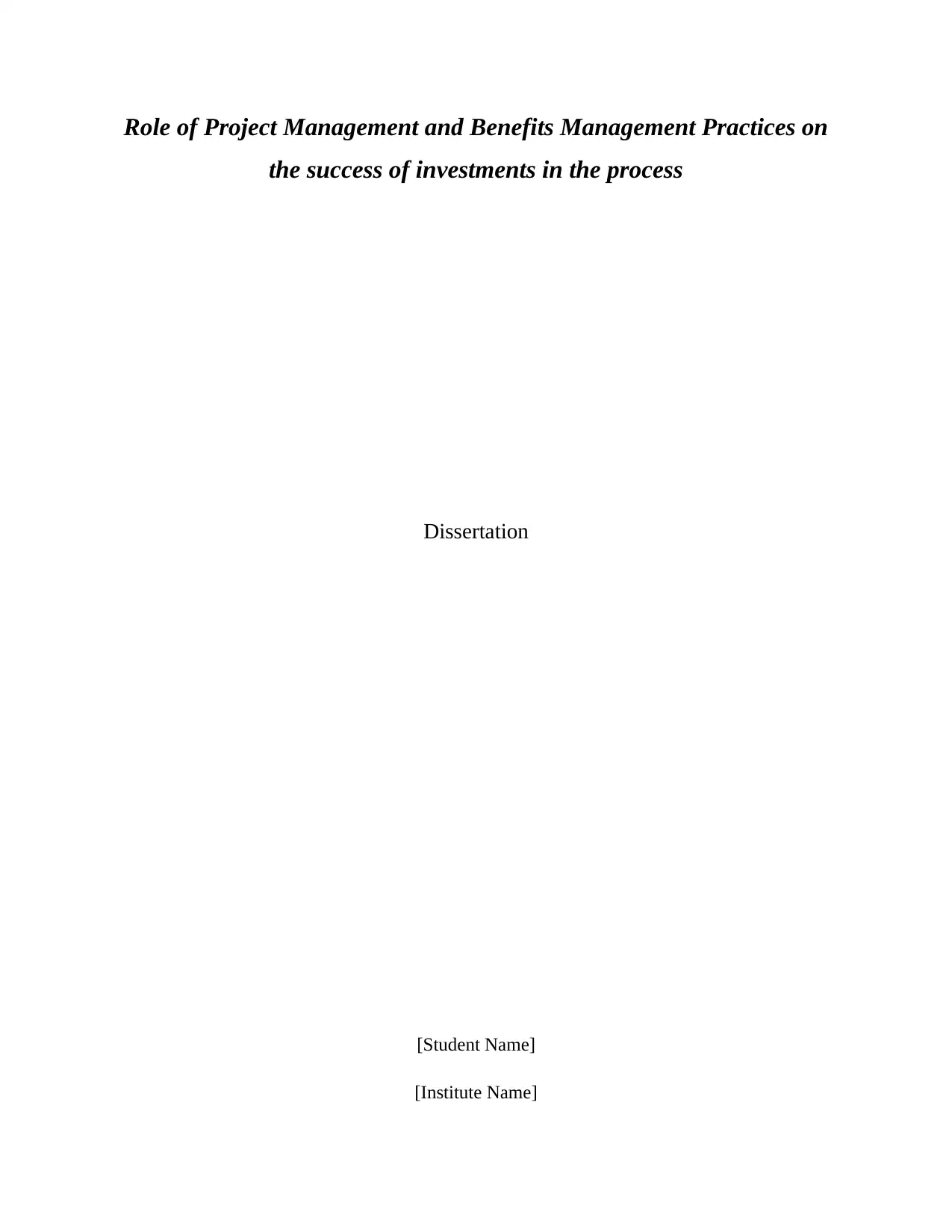
Role of Project Management and Benefits Management Practices on
the success of investments in the process
Dissertation
[Student Name]
[Institute Name]
the success of investments in the process
Dissertation
[Student Name]
[Institute Name]
Paraphrase This Document
Need a fresh take? Get an instant paraphrase of this document with our AI Paraphraser
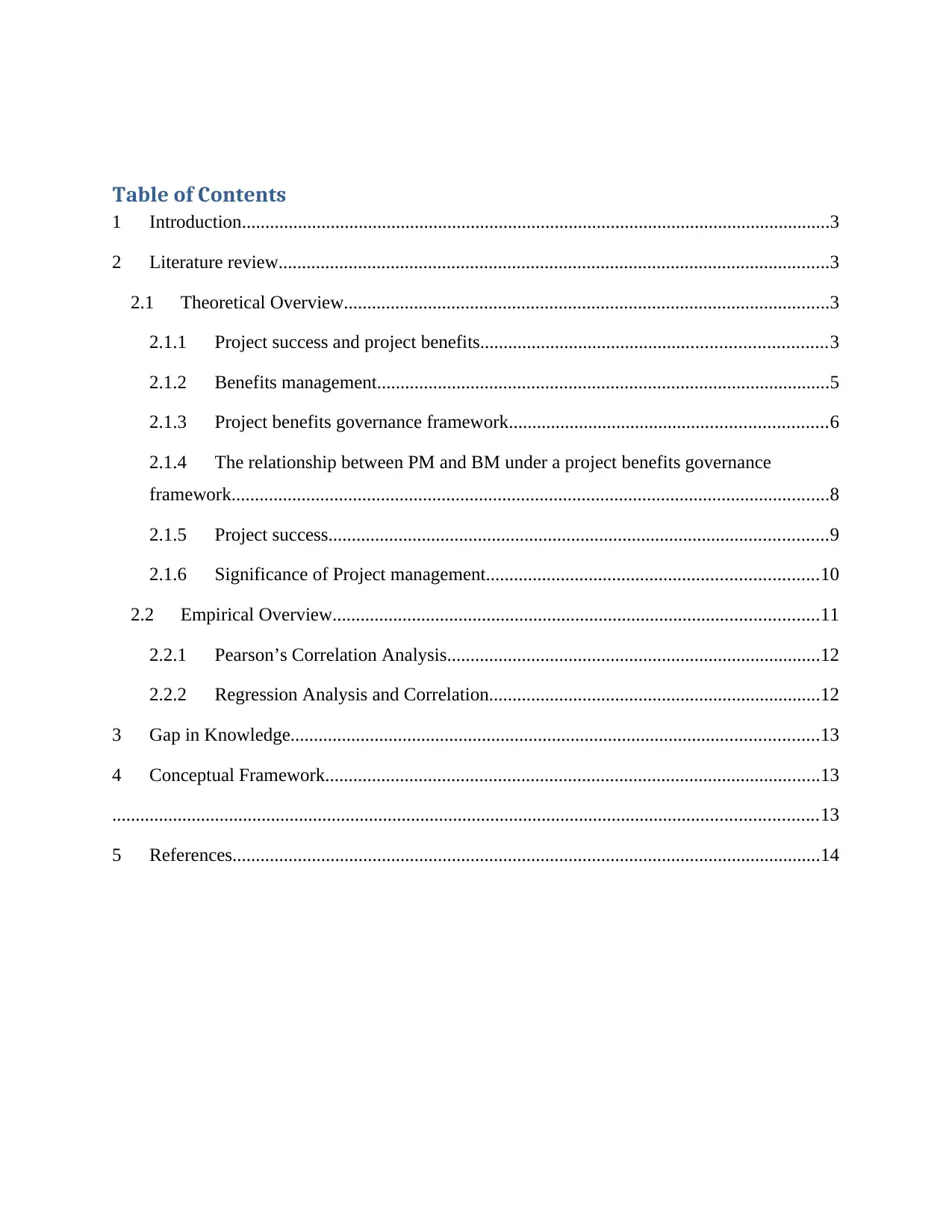
Table of Contents
1 Introduction..............................................................................................................................3
2 Literature review......................................................................................................................3
2.1 Theoretical Overview........................................................................................................3
2.1.1 Project success and project benefits..........................................................................3
2.1.2 Benefits management.................................................................................................5
2.1.3 Project benefits governance framework....................................................................6
2.1.4 The relationship between PM and BM under a project benefits governance
framework................................................................................................................................8
2.1.5 Project success...........................................................................................................9
2.1.6 Significance of Project management.......................................................................10
2.2 Empirical Overview........................................................................................................11
2.2.1 Pearson’s Correlation Analysis................................................................................12
2.2.2 Regression Analysis and Correlation.......................................................................12
3 Gap in Knowledge.................................................................................................................13
4 Conceptual Framework..........................................................................................................13
.......................................................................................................................................................13
5 References..............................................................................................................................14
1 Introduction..............................................................................................................................3
2 Literature review......................................................................................................................3
2.1 Theoretical Overview........................................................................................................3
2.1.1 Project success and project benefits..........................................................................3
2.1.2 Benefits management.................................................................................................5
2.1.3 Project benefits governance framework....................................................................6
2.1.4 The relationship between PM and BM under a project benefits governance
framework................................................................................................................................8
2.1.5 Project success...........................................................................................................9
2.1.6 Significance of Project management.......................................................................10
2.2 Empirical Overview........................................................................................................11
2.2.1 Pearson’s Correlation Analysis................................................................................12
2.2.2 Regression Analysis and Correlation.......................................................................12
3 Gap in Knowledge.................................................................................................................13
4 Conceptual Framework..........................................................................................................13
.......................................................................................................................................................13
5 References..............................................................................................................................14
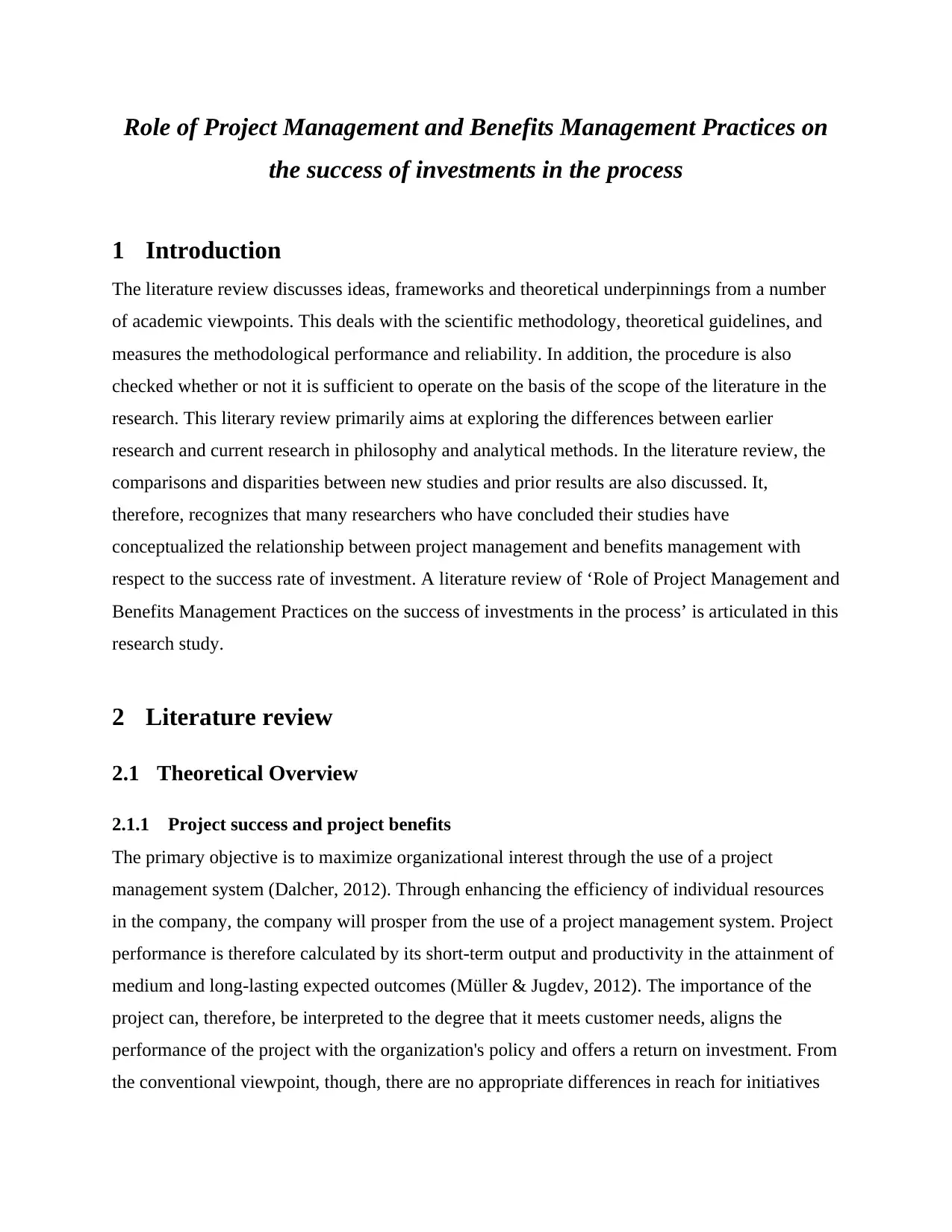
Role of Project Management and Benefits Management Practices on
the success of investments in the process
1 Introduction
The literature review discusses ideas, frameworks and theoretical underpinnings from a number
of academic viewpoints. This deals with the scientific methodology, theoretical guidelines, and
measures the methodological performance and reliability. In addition, the procedure is also
checked whether or not it is sufficient to operate on the basis of the scope of the literature in the
research. This literary review primarily aims at exploring the differences between earlier
research and current research in philosophy and analytical methods. In the literature review, the
comparisons and disparities between new studies and prior results are also discussed. It,
therefore, recognizes that many researchers who have concluded their studies have
conceptualized the relationship between project management and benefits management with
respect to the success rate of investment. A literature review of ‘Role of Project Management and
Benefits Management Practices on the success of investments in the process’ is articulated in this
research study.
2 Literature review
2.1 Theoretical Overview
2.1.1 Project success and project benefits
The primary objective is to maximize organizational interest through the use of a project
management system (Dalcher, 2012). Through enhancing the efficiency of individual resources
in the company, the company will prosper from the use of a project management system. Project
performance is therefore calculated by its short-term output and productivity in the attainment of
medium and long-lasting expected outcomes (Müller & Jugdev, 2012). The importance of the
project can, therefore, be interpreted to the degree that it meets customer needs, aligns the
performance of the project with the organization's policy and offers a return on investment. From
the conventional viewpoint, though, there are no appropriate differences in reach for initiatives
the success of investments in the process
1 Introduction
The literature review discusses ideas, frameworks and theoretical underpinnings from a number
of academic viewpoints. This deals with the scientific methodology, theoretical guidelines, and
measures the methodological performance and reliability. In addition, the procedure is also
checked whether or not it is sufficient to operate on the basis of the scope of the literature in the
research. This literary review primarily aims at exploring the differences between earlier
research and current research in philosophy and analytical methods. In the literature review, the
comparisons and disparities between new studies and prior results are also discussed. It,
therefore, recognizes that many researchers who have concluded their studies have
conceptualized the relationship between project management and benefits management with
respect to the success rate of investment. A literature review of ‘Role of Project Management and
Benefits Management Practices on the success of investments in the process’ is articulated in this
research study.
2 Literature review
2.1 Theoretical Overview
2.1.1 Project success and project benefits
The primary objective is to maximize organizational interest through the use of a project
management system (Dalcher, 2012). Through enhancing the efficiency of individual resources
in the company, the company will prosper from the use of a project management system. Project
performance is therefore calculated by its short-term output and productivity in the attainment of
medium and long-lasting expected outcomes (Müller & Jugdev, 2012). The importance of the
project can, therefore, be interpreted to the degree that it meets customer needs, aligns the
performance of the project with the organization's policy and offers a return on investment. From
the conventional viewpoint, though, there are no appropriate differences in reach for initiatives
⊘ This is a preview!⊘
Do you want full access?
Subscribe today to unlock all pages.

Trusted by 1+ million students worldwide
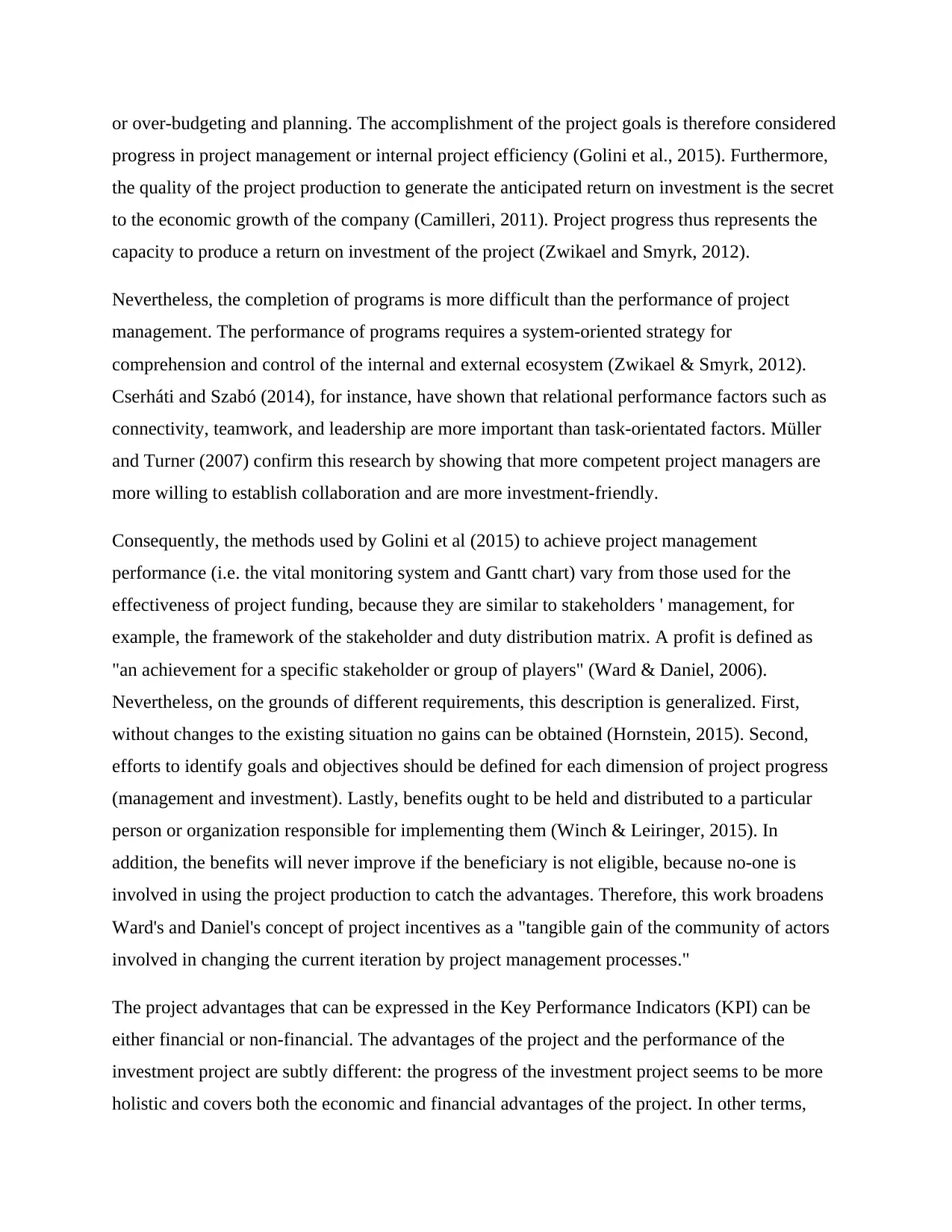
or over-budgeting and planning. The accomplishment of the project goals is therefore considered
progress in project management or internal project efficiency (Golini et al., 2015). Furthermore,
the quality of the project production to generate the anticipated return on investment is the secret
to the economic growth of the company (Camilleri, 2011). Project progress thus represents the
capacity to produce a return on investment of the project (Zwikael and Smyrk, 2012).
Nevertheless, the completion of programs is more difficult than the performance of project
management. The performance of programs requires a system-oriented strategy for
comprehension and control of the internal and external ecosystem (Zwikael & Smyrk, 2012).
Cserháti and Szabó (2014), for instance, have shown that relational performance factors such as
connectivity, teamwork, and leadership are more important than task-orientated factors. Müller
and Turner (2007) confirm this research by showing that more competent project managers are
more willing to establish collaboration and are more investment-friendly.
Consequently, the methods used by Golini et al (2015) to achieve project management
performance (i.e. the vital monitoring system and Gantt chart) vary from those used for the
effectiveness of project funding, because they are similar to stakeholders ' management, for
example, the framework of the stakeholder and duty distribution matrix. A profit is defined as
"an achievement for a specific stakeholder or group of players" (Ward & Daniel, 2006).
Nevertheless, on the grounds of different requirements, this description is generalized. First,
without changes to the existing situation no gains can be obtained (Hornstein, 2015). Second,
efforts to identify goals and objectives should be defined for each dimension of project progress
(management and investment). Lastly, benefits ought to be held and distributed to a particular
person or organization responsible for implementing them (Winch & Leiringer, 2015). In
addition, the benefits will never improve if the beneficiary is not eligible, because no-one is
involved in using the project production to catch the advantages. Therefore, this work broadens
Ward's and Daniel's concept of project incentives as a "tangible gain of the community of actors
involved in changing the current iteration by project management processes."
The project advantages that can be expressed in the Key Performance Indicators (KPI) can be
either financial or non-financial. The advantages of the project and the performance of the
investment project are subtly different: the progress of the investment project seems to be more
holistic and covers both the economic and financial advantages of the project. In other terms,
progress in project management or internal project efficiency (Golini et al., 2015). Furthermore,
the quality of the project production to generate the anticipated return on investment is the secret
to the economic growth of the company (Camilleri, 2011). Project progress thus represents the
capacity to produce a return on investment of the project (Zwikael and Smyrk, 2012).
Nevertheless, the completion of programs is more difficult than the performance of project
management. The performance of programs requires a system-oriented strategy for
comprehension and control of the internal and external ecosystem (Zwikael & Smyrk, 2012).
Cserháti and Szabó (2014), for instance, have shown that relational performance factors such as
connectivity, teamwork, and leadership are more important than task-orientated factors. Müller
and Turner (2007) confirm this research by showing that more competent project managers are
more willing to establish collaboration and are more investment-friendly.
Consequently, the methods used by Golini et al (2015) to achieve project management
performance (i.e. the vital monitoring system and Gantt chart) vary from those used for the
effectiveness of project funding, because they are similar to stakeholders ' management, for
example, the framework of the stakeholder and duty distribution matrix. A profit is defined as
"an achievement for a specific stakeholder or group of players" (Ward & Daniel, 2006).
Nevertheless, on the grounds of different requirements, this description is generalized. First,
without changes to the existing situation no gains can be obtained (Hornstein, 2015). Second,
efforts to identify goals and objectives should be defined for each dimension of project progress
(management and investment). Lastly, benefits ought to be held and distributed to a particular
person or organization responsible for implementing them (Winch & Leiringer, 2015). In
addition, the benefits will never improve if the beneficiary is not eligible, because no-one is
involved in using the project production to catch the advantages. Therefore, this work broadens
Ward's and Daniel's concept of project incentives as a "tangible gain of the community of actors
involved in changing the current iteration by project management processes."
The project advantages that can be expressed in the Key Performance Indicators (KPI) can be
either financial or non-financial. The advantages of the project and the performance of the
investment project are subtly different: the progress of the investment project seems to be more
holistic and covers both the economic and financial advantages of the project. In other terms,
Paraphrase This Document
Need a fresh take? Get an instant paraphrase of this document with our AI Paraphraser
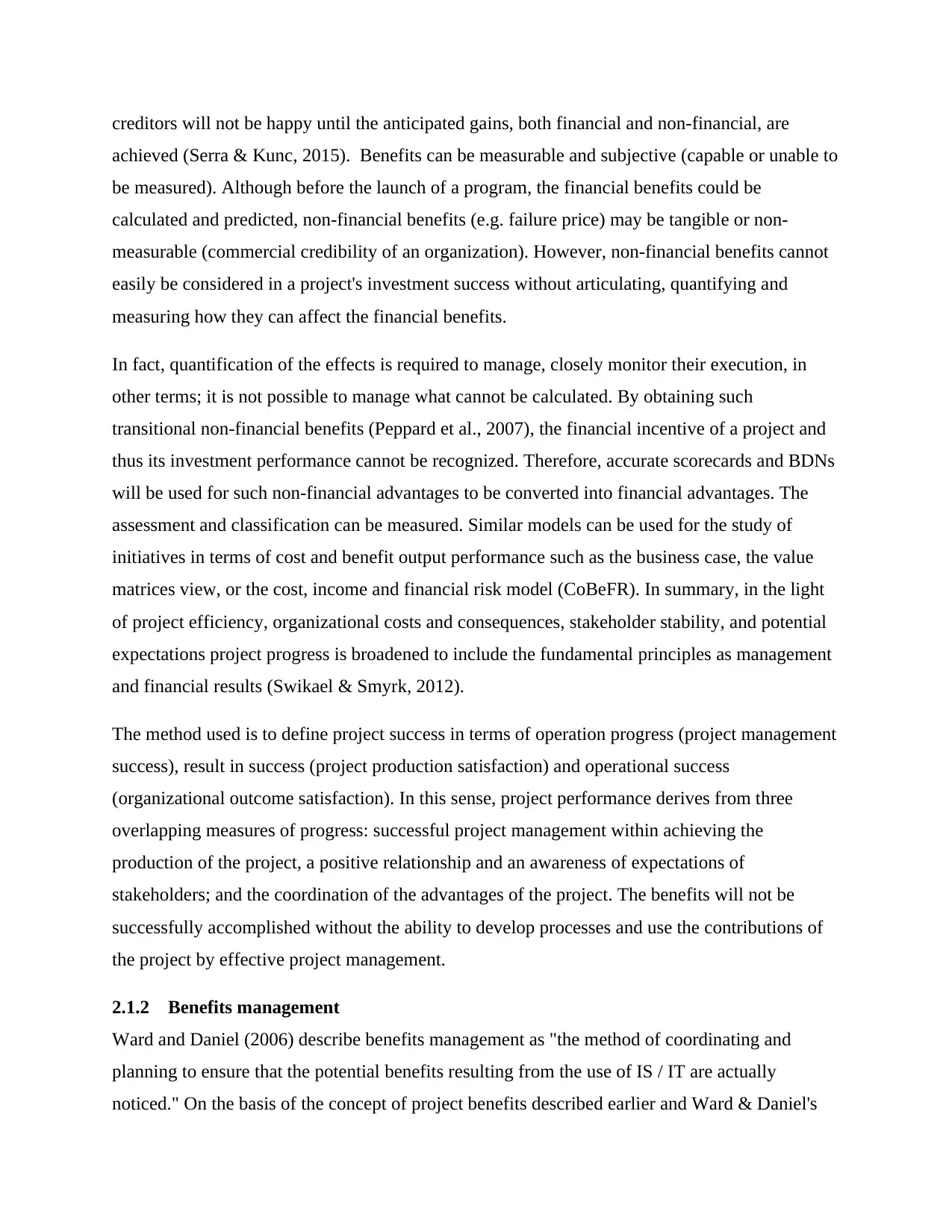
creditors will not be happy until the anticipated gains, both financial and non-financial, are
achieved (Serra & Kunc, 2015). Benefits can be measurable and subjective (capable or unable to
be measured). Although before the launch of a program, the financial benefits could be
calculated and predicted, non-financial benefits (e.g. failure price) may be tangible or non-
measurable (commercial credibility of an organization). However, non-financial benefits cannot
easily be considered in a project's investment success without articulating, quantifying and
measuring how they can affect the financial benefits.
In fact, quantification of the effects is required to manage, closely monitor their execution, in
other terms; it is not possible to manage what cannot be calculated. By obtaining such
transitional non-financial benefits (Peppard et al., 2007), the financial incentive of a project and
thus its investment performance cannot be recognized. Therefore, accurate scorecards and BDNs
will be used for such non-financial advantages to be converted into financial advantages. The
assessment and classification can be measured. Similar models can be used for the study of
initiatives in terms of cost and benefit output performance such as the business case, the value
matrices view, or the cost, income and financial risk model (CoBeFR). In summary, in the light
of project efficiency, organizational costs and consequences, stakeholder stability, and potential
expectations project progress is broadened to include the fundamental principles as management
and financial results (Swikael & Smyrk, 2012).
The method used is to define project success in terms of operation progress (project management
success), result in success (project production satisfaction) and operational success
(organizational outcome satisfaction). In this sense, project performance derives from three
overlapping measures of progress: successful project management within achieving the
production of the project, a positive relationship and an awareness of expectations of
stakeholders; and the coordination of the advantages of the project. The benefits will not be
successfully accomplished without the ability to develop processes and use the contributions of
the project by effective project management.
2.1.2 Benefits management
Ward and Daniel (2006) describe benefits management as "the method of coordinating and
planning to ensure that the potential benefits resulting from the use of IS / IT are actually
noticed." On the basis of the concept of project benefits described earlier and Ward & Daniel's
achieved (Serra & Kunc, 2015). Benefits can be measurable and subjective (capable or unable to
be measured). Although before the launch of a program, the financial benefits could be
calculated and predicted, non-financial benefits (e.g. failure price) may be tangible or non-
measurable (commercial credibility of an organization). However, non-financial benefits cannot
easily be considered in a project's investment success without articulating, quantifying and
measuring how they can affect the financial benefits.
In fact, quantification of the effects is required to manage, closely monitor their execution, in
other terms; it is not possible to manage what cannot be calculated. By obtaining such
transitional non-financial benefits (Peppard et al., 2007), the financial incentive of a project and
thus its investment performance cannot be recognized. Therefore, accurate scorecards and BDNs
will be used for such non-financial advantages to be converted into financial advantages. The
assessment and classification can be measured. Similar models can be used for the study of
initiatives in terms of cost and benefit output performance such as the business case, the value
matrices view, or the cost, income and financial risk model (CoBeFR). In summary, in the light
of project efficiency, organizational costs and consequences, stakeholder stability, and potential
expectations project progress is broadened to include the fundamental principles as management
and financial results (Swikael & Smyrk, 2012).
The method used is to define project success in terms of operation progress (project management
success), result in success (project production satisfaction) and operational success
(organizational outcome satisfaction). In this sense, project performance derives from three
overlapping measures of progress: successful project management within achieving the
production of the project, a positive relationship and an awareness of expectations of
stakeholders; and the coordination of the advantages of the project. The benefits will not be
successfully accomplished without the ability to develop processes and use the contributions of
the project by effective project management.
2.1.2 Benefits management
Ward and Daniel (2006) describe benefits management as "the method of coordinating and
planning to ensure that the potential benefits resulting from the use of IS / IT are actually
noticed." On the basis of the concept of project benefits described earlier and Ward & Daniel's
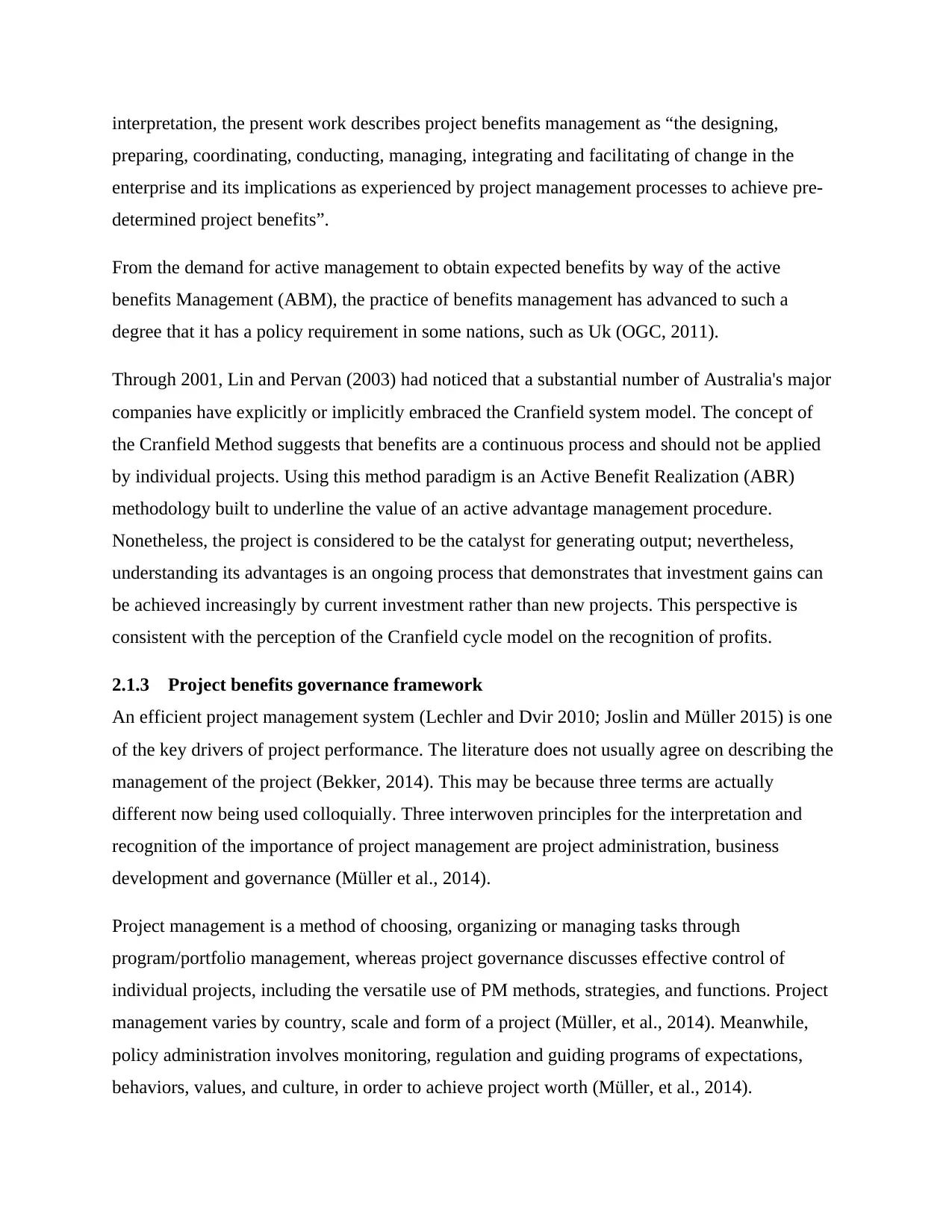
interpretation, the present work describes project benefits management as “the designing,
preparing, coordinating, conducting, managing, integrating and facilitating of change in the
enterprise and its implications as experienced by project management processes to achieve pre-
determined project benefits”.
From the demand for active management to obtain expected benefits by way of the active
benefits Management (ABM), the practice of benefits management has advanced to such a
degree that it has a policy requirement in some nations, such as Uk (OGC, 2011).
Through 2001, Lin and Pervan (2003) had noticed that a substantial number of Australia's major
companies have explicitly or implicitly embraced the Cranfield system model. The concept of
the Cranfield Method suggests that benefits are a continuous process and should not be applied
by individual projects. Using this method paradigm is an Active Benefit Realization (ABR)
methodology built to underline the value of an active advantage management procedure.
Nonetheless, the project is considered to be the catalyst for generating output; nevertheless,
understanding its advantages is an ongoing process that demonstrates that investment gains can
be achieved increasingly by current investment rather than new projects. This perspective is
consistent with the perception of the Cranfield cycle model on the recognition of profits.
2.1.3 Project benefits governance framework
An efficient project management system (Lechler and Dvir 2010; Joslin and Müller 2015) is one
of the key drivers of project performance. The literature does not usually agree on describing the
management of the project (Bekker, 2014). This may be because three terms are actually
different now being used colloquially. Three interwoven principles for the interpretation and
recognition of the importance of project management are project administration, business
development and governance (Müller et al., 2014).
Project management is a method of choosing, organizing or managing tasks through
program/portfolio management, whereas project governance discusses effective control of
individual projects, including the versatile use of PM methods, strategies, and functions. Project
management varies by country, scale and form of a project (Müller, et al., 2014). Meanwhile,
policy administration involves monitoring, regulation and guiding programs of expectations,
behaviors, values, and culture, in order to achieve project worth (Müller, et al., 2014).
preparing, coordinating, conducting, managing, integrating and facilitating of change in the
enterprise and its implications as experienced by project management processes to achieve pre-
determined project benefits”.
From the demand for active management to obtain expected benefits by way of the active
benefits Management (ABM), the practice of benefits management has advanced to such a
degree that it has a policy requirement in some nations, such as Uk (OGC, 2011).
Through 2001, Lin and Pervan (2003) had noticed that a substantial number of Australia's major
companies have explicitly or implicitly embraced the Cranfield system model. The concept of
the Cranfield Method suggests that benefits are a continuous process and should not be applied
by individual projects. Using this method paradigm is an Active Benefit Realization (ABR)
methodology built to underline the value of an active advantage management procedure.
Nonetheless, the project is considered to be the catalyst for generating output; nevertheless,
understanding its advantages is an ongoing process that demonstrates that investment gains can
be achieved increasingly by current investment rather than new projects. This perspective is
consistent with the perception of the Cranfield cycle model on the recognition of profits.
2.1.3 Project benefits governance framework
An efficient project management system (Lechler and Dvir 2010; Joslin and Müller 2015) is one
of the key drivers of project performance. The literature does not usually agree on describing the
management of the project (Bekker, 2014). This may be because three terms are actually
different now being used colloquially. Three interwoven principles for the interpretation and
recognition of the importance of project management are project administration, business
development and governance (Müller et al., 2014).
Project management is a method of choosing, organizing or managing tasks through
program/portfolio management, whereas project governance discusses effective control of
individual projects, including the versatile use of PM methods, strategies, and functions. Project
management varies by country, scale and form of a project (Müller, et al., 2014). Meanwhile,
policy administration involves monitoring, regulation and guiding programs of expectations,
behaviors, values, and culture, in order to achieve project worth (Müller, et al., 2014).
⊘ This is a preview!⊘
Do you want full access?
Subscribe today to unlock all pages.

Trusted by 1+ million students worldwide
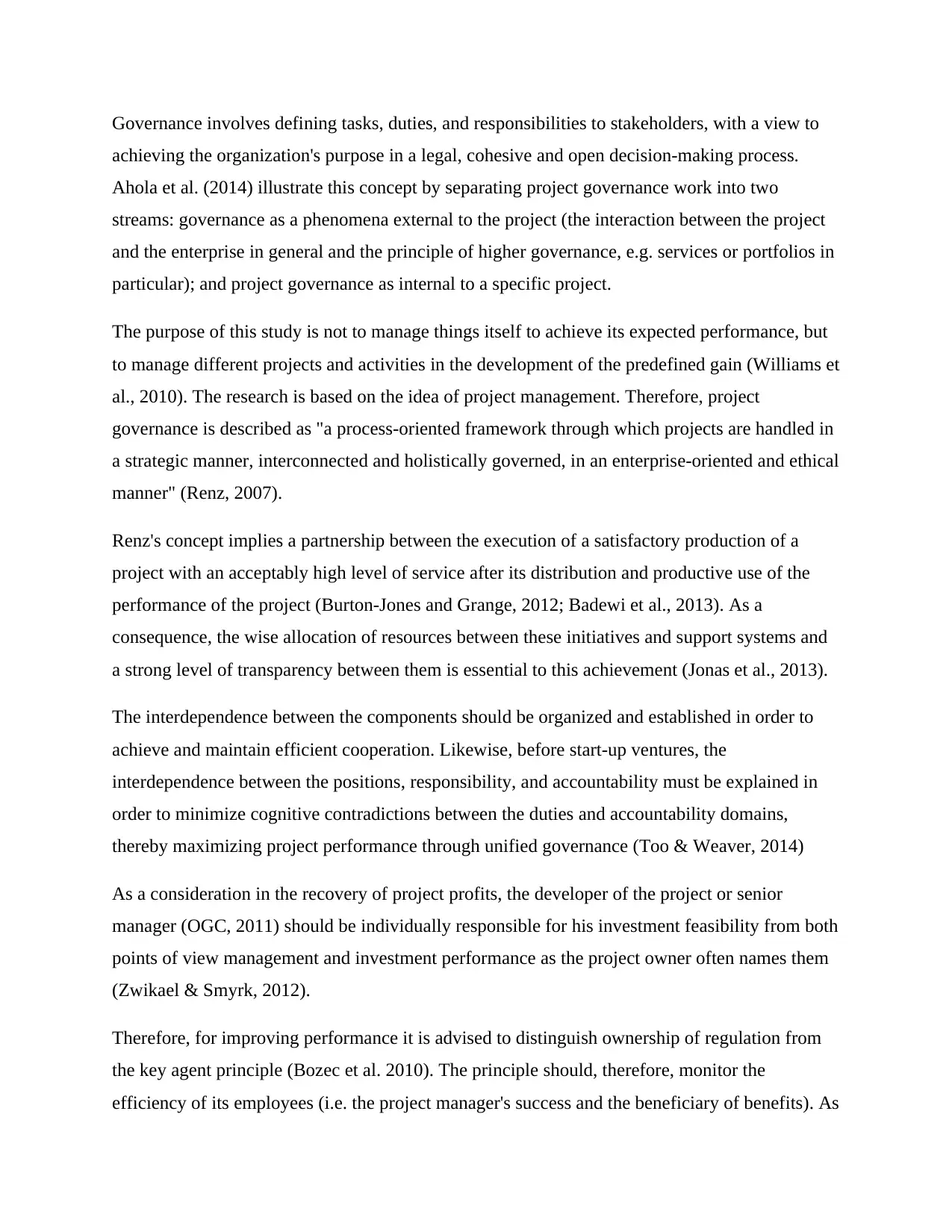
Governance involves defining tasks, duties, and responsibilities to stakeholders, with a view to
achieving the organization's purpose in a legal, cohesive and open decision-making process.
Ahola et al. (2014) illustrate this concept by separating project governance work into two
streams: governance as a phenomena external to the project (the interaction between the project
and the enterprise in general and the principle of higher governance, e.g. services or portfolios in
particular); and project governance as internal to a specific project.
The purpose of this study is not to manage things itself to achieve its expected performance, but
to manage different projects and activities in the development of the predefined gain (Williams et
al., 2010). The research is based on the idea of project management. Therefore, project
governance is described as "a process-oriented framework through which projects are handled in
a strategic manner, interconnected and holistically governed, in an enterprise-oriented and ethical
manner" (Renz, 2007).
Renz's concept implies a partnership between the execution of a satisfactory production of a
project with an acceptably high level of service after its distribution and productive use of the
performance of the project (Burton-Jones and Grange, 2012; Badewi et al., 2013). As a
consequence, the wise allocation of resources between these initiatives and support systems and
a strong level of transparency between them is essential to this achievement (Jonas et al., 2013).
The interdependence between the components should be organized and established in order to
achieve and maintain efficient cooperation. Likewise, before start-up ventures, the
interdependence between the positions, responsibility, and accountability must be explained in
order to minimize cognitive contradictions between the duties and accountability domains,
thereby maximizing project performance through unified governance (Too & Weaver, 2014)
As a consideration in the recovery of project profits, the developer of the project or senior
manager (OGC, 2011) should be individually responsible for his investment feasibility from both
points of view management and investment performance as the project owner often names them
(Zwikael & Smyrk, 2012).
Therefore, for improving performance it is advised to distinguish ownership of regulation from
the key agent principle (Bozec et al. 2010). The principle should, therefore, monitor the
efficiency of its employees (i.e. the project manager's success and the beneficiary of benefits). As
achieving the organization's purpose in a legal, cohesive and open decision-making process.
Ahola et al. (2014) illustrate this concept by separating project governance work into two
streams: governance as a phenomena external to the project (the interaction between the project
and the enterprise in general and the principle of higher governance, e.g. services or portfolios in
particular); and project governance as internal to a specific project.
The purpose of this study is not to manage things itself to achieve its expected performance, but
to manage different projects and activities in the development of the predefined gain (Williams et
al., 2010). The research is based on the idea of project management. Therefore, project
governance is described as "a process-oriented framework through which projects are handled in
a strategic manner, interconnected and holistically governed, in an enterprise-oriented and ethical
manner" (Renz, 2007).
Renz's concept implies a partnership between the execution of a satisfactory production of a
project with an acceptably high level of service after its distribution and productive use of the
performance of the project (Burton-Jones and Grange, 2012; Badewi et al., 2013). As a
consequence, the wise allocation of resources between these initiatives and support systems and
a strong level of transparency between them is essential to this achievement (Jonas et al., 2013).
The interdependence between the components should be organized and established in order to
achieve and maintain efficient cooperation. Likewise, before start-up ventures, the
interdependence between the positions, responsibility, and accountability must be explained in
order to minimize cognitive contradictions between the duties and accountability domains,
thereby maximizing project performance through unified governance (Too & Weaver, 2014)
As a consideration in the recovery of project profits, the developer of the project or senior
manager (OGC, 2011) should be individually responsible for his investment feasibility from both
points of view management and investment performance as the project owner often names them
(Zwikael & Smyrk, 2012).
Therefore, for improving performance it is advised to distinguish ownership of regulation from
the key agent principle (Bozec et al. 2010). The principle should, therefore, monitor the
efficiency of its employees (i.e. the project manager's success and the beneficiary of benefits). As
Paraphrase This Document
Need a fresh take? Get an instant paraphrase of this document with our AI Paraphraser
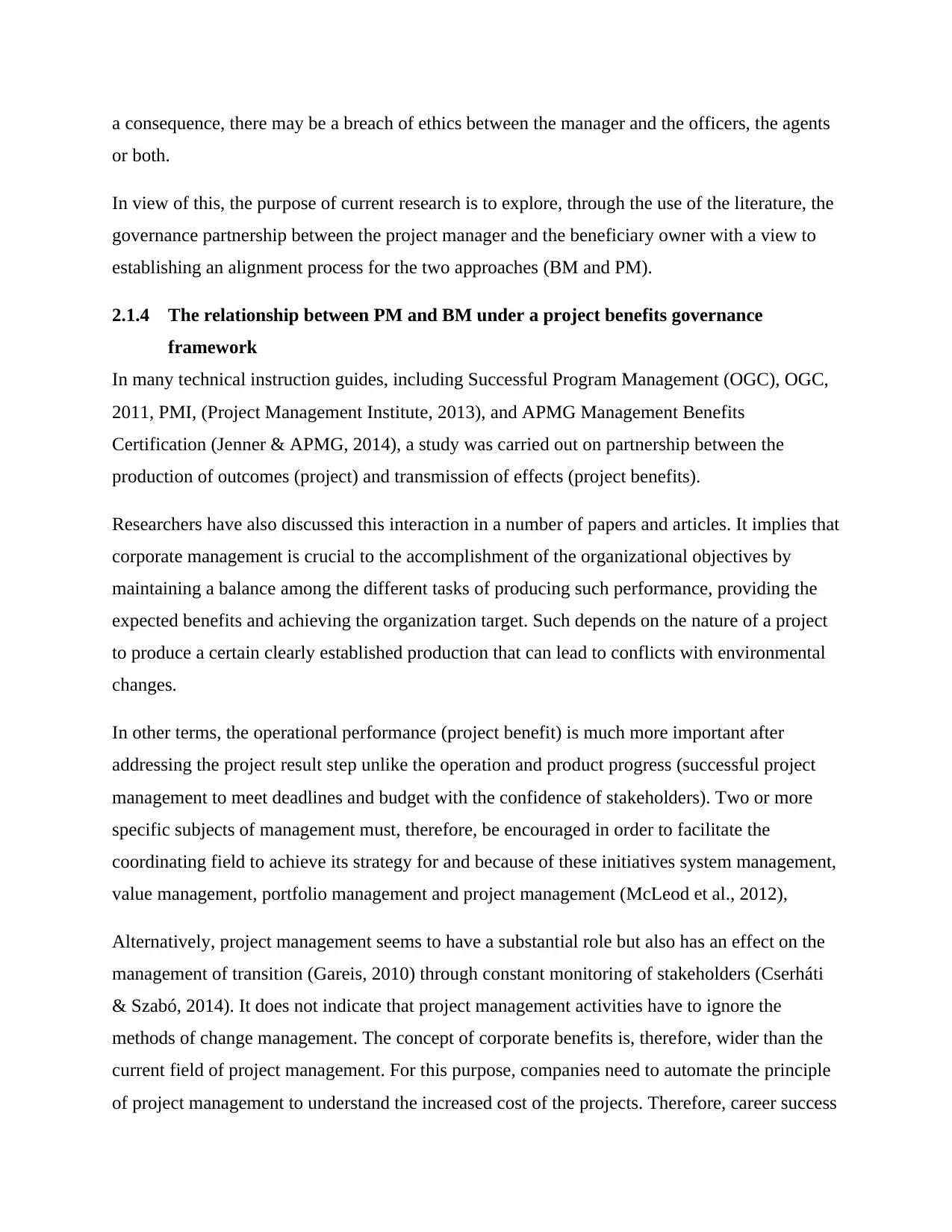
a consequence, there may be a breach of ethics between the manager and the officers, the agents
or both.
In view of this, the purpose of current research is to explore, through the use of the literature, the
governance partnership between the project manager and the beneficiary owner with a view to
establishing an alignment process for the two approaches (BM and PM).
2.1.4 The relationship between PM and BM under a project benefits governance
framework
In many technical instruction guides, including Successful Program Management (OGC), OGC,
2011, PMI, (Project Management Institute, 2013), and APMG Management Benefits
Certification (Jenner & APMG, 2014), a study was carried out on partnership between the
production of outcomes (project) and transmission of effects (project benefits).
Researchers have also discussed this interaction in a number of papers and articles. It implies that
corporate management is crucial to the accomplishment of the organizational objectives by
maintaining a balance among the different tasks of producing such performance, providing the
expected benefits and achieving the organization target. Such depends on the nature of a project
to produce a certain clearly established production that can lead to conflicts with environmental
changes.
In other terms, the operational performance (project benefit) is much more important after
addressing the project result step unlike the operation and product progress (successful project
management to meet deadlines and budget with the confidence of stakeholders). Two or more
specific subjects of management must, therefore, be encouraged in order to facilitate the
coordinating field to achieve its strategy for and because of these initiatives system management,
value management, portfolio management and project management (McLeod et al., 2012),
Alternatively, project management seems to have a substantial role but also has an effect on the
management of transition (Gareis, 2010) through constant monitoring of stakeholders (Cserháti
& Szabó, 2014). It does not indicate that project management activities have to ignore the
methods of change management. The concept of corporate benefits is, therefore, wider than the
current field of project management. For this purpose, companies need to automate the principle
of project management to understand the increased cost of the projects. Therefore, career success
or both.
In view of this, the purpose of current research is to explore, through the use of the literature, the
governance partnership between the project manager and the beneficiary owner with a view to
establishing an alignment process for the two approaches (BM and PM).
2.1.4 The relationship between PM and BM under a project benefits governance
framework
In many technical instruction guides, including Successful Program Management (OGC), OGC,
2011, PMI, (Project Management Institute, 2013), and APMG Management Benefits
Certification (Jenner & APMG, 2014), a study was carried out on partnership between the
production of outcomes (project) and transmission of effects (project benefits).
Researchers have also discussed this interaction in a number of papers and articles. It implies that
corporate management is crucial to the accomplishment of the organizational objectives by
maintaining a balance among the different tasks of producing such performance, providing the
expected benefits and achieving the organization target. Such depends on the nature of a project
to produce a certain clearly established production that can lead to conflicts with environmental
changes.
In other terms, the operational performance (project benefit) is much more important after
addressing the project result step unlike the operation and product progress (successful project
management to meet deadlines and budget with the confidence of stakeholders). Two or more
specific subjects of management must, therefore, be encouraged in order to facilitate the
coordinating field to achieve its strategy for and because of these initiatives system management,
value management, portfolio management and project management (McLeod et al., 2012),
Alternatively, project management seems to have a substantial role but also has an effect on the
management of transition (Gareis, 2010) through constant monitoring of stakeholders (Cserháti
& Szabó, 2014). It does not indicate that project management activities have to ignore the
methods of change management. The concept of corporate benefits is, therefore, wider than the
current field of project management. For this purpose, companies need to automate the principle
of project management to understand the increased cost of the projects. Therefore, career success
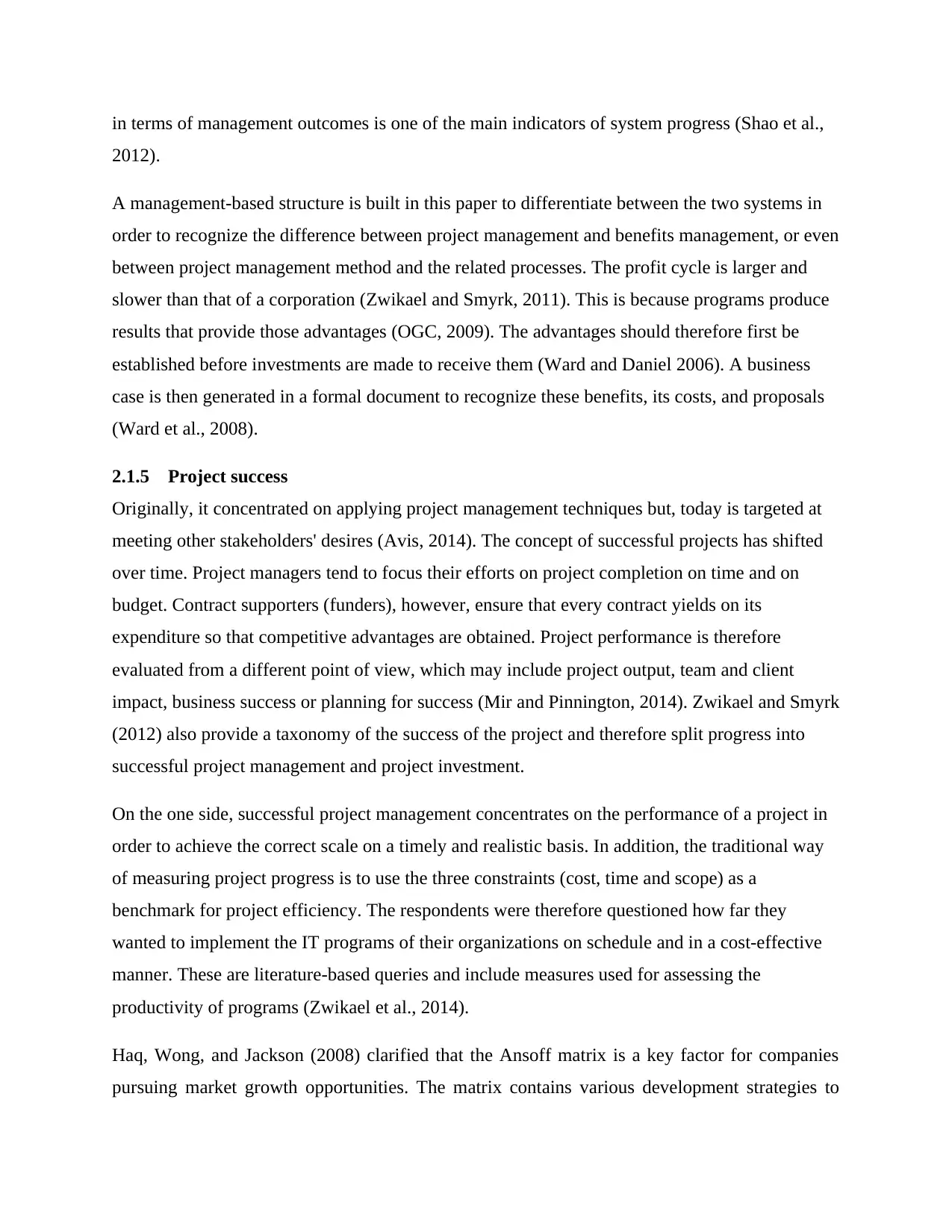
in terms of management outcomes is one of the main indicators of system progress (Shao et al.,
2012).
A management-based structure is built in this paper to differentiate between the two systems in
order to recognize the difference between project management and benefits management, or even
between project management method and the related processes. The profit cycle is larger and
slower than that of a corporation (Zwikael and Smyrk, 2011). This is because programs produce
results that provide those advantages (OGC, 2009). The advantages should therefore first be
established before investments are made to receive them (Ward and Daniel 2006). A business
case is then generated in a formal document to recognize these benefits, its costs, and proposals
(Ward et al., 2008).
2.1.5 Project success
Originally, it concentrated on applying project management techniques but, today is targeted at
meeting other stakeholders' desires (Avis, 2014). The concept of successful projects has shifted
over time. Project managers tend to focus their efforts on project completion on time and on
budget. Contract supporters (funders), however, ensure that every contract yields on its
expenditure so that competitive advantages are obtained. Project performance is therefore
evaluated from a different point of view, which may include project output, team and client
impact, business success or planning for success (Mir and Pinnington, 2014). Zwikael and Smyrk
(2012) also provide a taxonomy of the success of the project and therefore split progress into
successful project management and project investment.
On the one side, successful project management concentrates on the performance of a project in
order to achieve the correct scale on a timely and realistic basis. In addition, the traditional way
of measuring project progress is to use the three constraints (cost, time and scope) as a
benchmark for project efficiency. The respondents were therefore questioned how far they
wanted to implement the IT programs of their organizations on schedule and in a cost-effective
manner. These are literature-based queries and include measures used for assessing the
productivity of programs (Zwikael et al., 2014).
Haq, Wong, and Jackson (2008) clarified that the Ansoff matrix is a key factor for companies
pursuing market growth opportunities. The matrix contains various development strategies to
2012).
A management-based structure is built in this paper to differentiate between the two systems in
order to recognize the difference between project management and benefits management, or even
between project management method and the related processes. The profit cycle is larger and
slower than that of a corporation (Zwikael and Smyrk, 2011). This is because programs produce
results that provide those advantages (OGC, 2009). The advantages should therefore first be
established before investments are made to receive them (Ward and Daniel 2006). A business
case is then generated in a formal document to recognize these benefits, its costs, and proposals
(Ward et al., 2008).
2.1.5 Project success
Originally, it concentrated on applying project management techniques but, today is targeted at
meeting other stakeholders' desires (Avis, 2014). The concept of successful projects has shifted
over time. Project managers tend to focus their efforts on project completion on time and on
budget. Contract supporters (funders), however, ensure that every contract yields on its
expenditure so that competitive advantages are obtained. Project performance is therefore
evaluated from a different point of view, which may include project output, team and client
impact, business success or planning for success (Mir and Pinnington, 2014). Zwikael and Smyrk
(2012) also provide a taxonomy of the success of the project and therefore split progress into
successful project management and project investment.
On the one side, successful project management concentrates on the performance of a project in
order to achieve the correct scale on a timely and realistic basis. In addition, the traditional way
of measuring project progress is to use the three constraints (cost, time and scope) as a
benchmark for project efficiency. The respondents were therefore questioned how far they
wanted to implement the IT programs of their organizations on schedule and in a cost-effective
manner. These are literature-based queries and include measures used for assessing the
productivity of programs (Zwikael et al., 2014).
Haq, Wong, and Jackson (2008) clarified that the Ansoff matrix is a key factor for companies
pursuing market growth opportunities. The matrix contains various development strategies to
⊘ This is a preview!⊘
Do you want full access?
Subscribe today to unlock all pages.

Trusted by 1+ million students worldwide
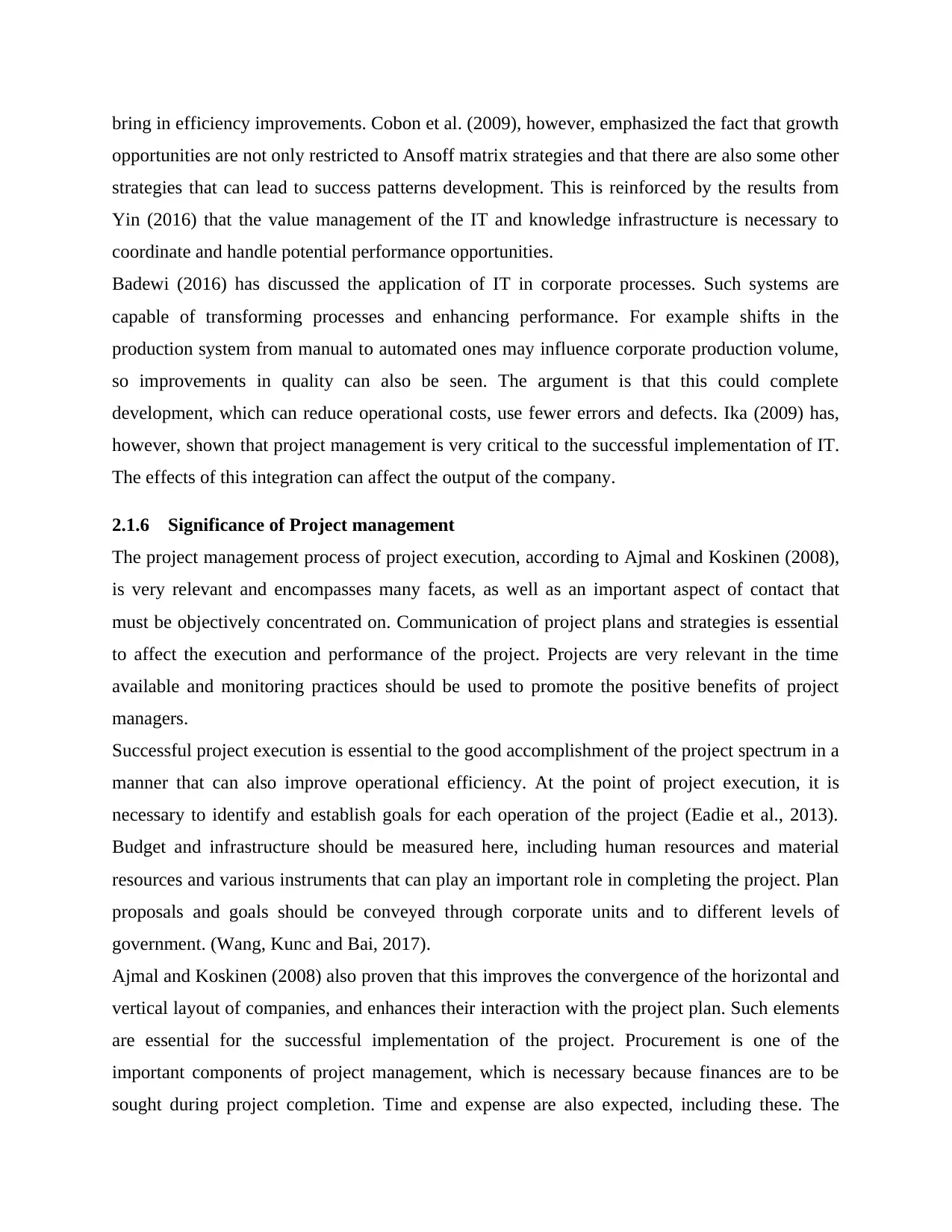
bring in efficiency improvements. Cobon et al. (2009), however, emphasized the fact that growth
opportunities are not only restricted to Ansoff matrix strategies and that there are also some other
strategies that can lead to success patterns development. This is reinforced by the results from
Yin (2016) that the value management of the IT and knowledge infrastructure is necessary to
coordinate and handle potential performance opportunities.
Badewi (2016) has discussed the application of IT in corporate processes. Such systems are
capable of transforming processes and enhancing performance. For example shifts in the
production system from manual to automated ones may influence corporate production volume,
so improvements in quality can also be seen. The argument is that this could complete
development, which can reduce operational costs, use fewer errors and defects. Ika (2009) has,
however, shown that project management is very critical to the successful implementation of IT.
The effects of this integration can affect the output of the company.
2.1.6 Significance of Project management
The project management process of project execution, according to Ajmal and Koskinen (2008),
is very relevant and encompasses many facets, as well as an important aspect of contact that
must be objectively concentrated on. Communication of project plans and strategies is essential
to affect the execution and performance of the project. Projects are very relevant in the time
available and monitoring practices should be used to promote the positive benefits of project
managers.
Successful project execution is essential to the good accomplishment of the project spectrum in a
manner that can also improve operational efficiency. At the point of project execution, it is
necessary to identify and establish goals for each operation of the project (Eadie et al., 2013).
Budget and infrastructure should be measured here, including human resources and material
resources and various instruments that can play an important role in completing the project. Plan
proposals and goals should be conveyed through corporate units and to different levels of
government. (Wang, Kunc and Bai, 2017).
Ajmal and Koskinen (2008) also proven that this improves the convergence of the horizontal and
vertical layout of companies, and enhances their interaction with the project plan. Such elements
are essential for the successful implementation of the project. Procurement is one of the
important components of project management, which is necessary because finances are to be
sought during project completion. Time and expense are also expected, including these. The
opportunities are not only restricted to Ansoff matrix strategies and that there are also some other
strategies that can lead to success patterns development. This is reinforced by the results from
Yin (2016) that the value management of the IT and knowledge infrastructure is necessary to
coordinate and handle potential performance opportunities.
Badewi (2016) has discussed the application of IT in corporate processes. Such systems are
capable of transforming processes and enhancing performance. For example shifts in the
production system from manual to automated ones may influence corporate production volume,
so improvements in quality can also be seen. The argument is that this could complete
development, which can reduce operational costs, use fewer errors and defects. Ika (2009) has,
however, shown that project management is very critical to the successful implementation of IT.
The effects of this integration can affect the output of the company.
2.1.6 Significance of Project management
The project management process of project execution, according to Ajmal and Koskinen (2008),
is very relevant and encompasses many facets, as well as an important aspect of contact that
must be objectively concentrated on. Communication of project plans and strategies is essential
to affect the execution and performance of the project. Projects are very relevant in the time
available and monitoring practices should be used to promote the positive benefits of project
managers.
Successful project execution is essential to the good accomplishment of the project spectrum in a
manner that can also improve operational efficiency. At the point of project execution, it is
necessary to identify and establish goals for each operation of the project (Eadie et al., 2013).
Budget and infrastructure should be measured here, including human resources and material
resources and various instruments that can play an important role in completing the project. Plan
proposals and goals should be conveyed through corporate units and to different levels of
government. (Wang, Kunc and Bai, 2017).
Ajmal and Koskinen (2008) also proven that this improves the convergence of the horizontal and
vertical layout of companies, and enhances their interaction with the project plan. Such elements
are essential for the successful implementation of the project. Procurement is one of the
important components of project management, which is necessary because finances are to be
sought during project completion. Time and expense are also expected, including these. The
Paraphrase This Document
Need a fresh take? Get an instant paraphrase of this document with our AI Paraphraser
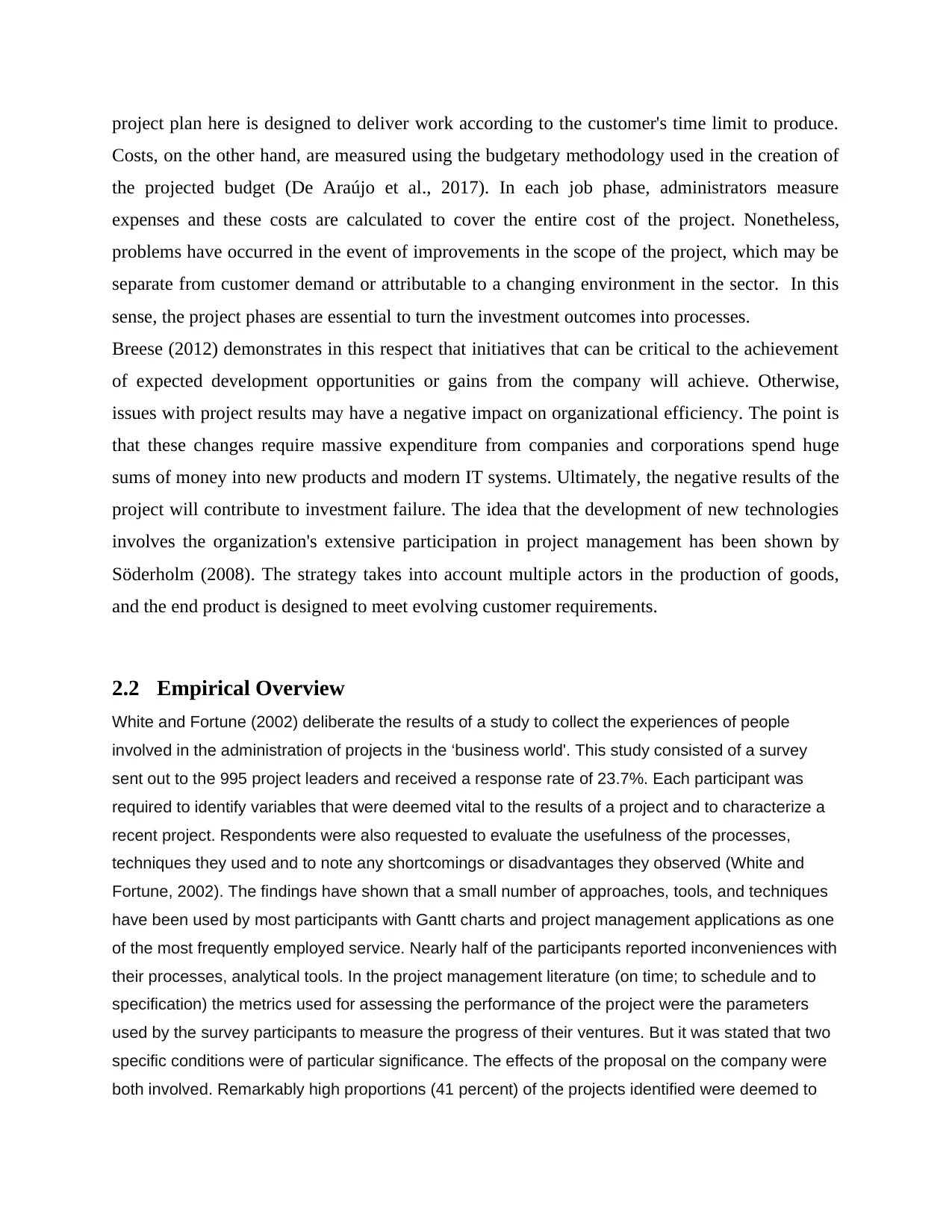
project plan here is designed to deliver work according to the customer's time limit to produce.
Costs, on the other hand, are measured using the budgetary methodology used in the creation of
the projected budget (De Araújo et al., 2017). In each job phase, administrators measure
expenses and these costs are calculated to cover the entire cost of the project. Nonetheless,
problems have occurred in the event of improvements in the scope of the project, which may be
separate from customer demand or attributable to a changing environment in the sector. In this
sense, the project phases are essential to turn the investment outcomes into processes.
Breese (2012) demonstrates in this respect that initiatives that can be critical to the achievement
of expected development opportunities or gains from the company will achieve. Otherwise,
issues with project results may have a negative impact on organizational efficiency. The point is
that these changes require massive expenditure from companies and corporations spend huge
sums of money into new products and modern IT systems. Ultimately, the negative results of the
project will contribute to investment failure. The idea that the development of new technologies
involves the organization's extensive participation in project management has been shown by
Söderholm (2008). The strategy takes into account multiple actors in the production of goods,
and the end product is designed to meet evolving customer requirements.
2.2 Empirical Overview
White and Fortune (2002) deliberate the results of a study to collect the experiences of people
involved in the administration of projects in the ‘business world'. This study consisted of a survey
sent out to the 995 project leaders and received a response rate of 23.7%. Each participant was
required to identify variables that were deemed vital to the results of a project and to characterize a
recent project. Respondents were also requested to evaluate the usefulness of the processes,
techniques they used and to note any shortcomings or disadvantages they observed (White and
Fortune, 2002). The findings have shown that a small number of approaches, tools, and techniques
have been used by most participants with Gantt charts and project management applications as one
of the most frequently employed service. Nearly half of the participants reported inconveniences with
their processes, analytical tools. In the project management literature (on time; to schedule and to
specification) the metrics used for assessing the performance of the project were the parameters
used by the survey participants to measure the progress of their ventures. But it was stated that two
specific conditions were of particular significance. The effects of the proposal on the company were
both involved. Remarkably high proportions (41 percent) of the projects identified were deemed to
Costs, on the other hand, are measured using the budgetary methodology used in the creation of
the projected budget (De Araújo et al., 2017). In each job phase, administrators measure
expenses and these costs are calculated to cover the entire cost of the project. Nonetheless,
problems have occurred in the event of improvements in the scope of the project, which may be
separate from customer demand or attributable to a changing environment in the sector. In this
sense, the project phases are essential to turn the investment outcomes into processes.
Breese (2012) demonstrates in this respect that initiatives that can be critical to the achievement
of expected development opportunities or gains from the company will achieve. Otherwise,
issues with project results may have a negative impact on organizational efficiency. The point is
that these changes require massive expenditure from companies and corporations spend huge
sums of money into new products and modern IT systems. Ultimately, the negative results of the
project will contribute to investment failure. The idea that the development of new technologies
involves the organization's extensive participation in project management has been shown by
Söderholm (2008). The strategy takes into account multiple actors in the production of goods,
and the end product is designed to meet evolving customer requirements.
2.2 Empirical Overview
White and Fortune (2002) deliberate the results of a study to collect the experiences of people
involved in the administration of projects in the ‘business world'. This study consisted of a survey
sent out to the 995 project leaders and received a response rate of 23.7%. Each participant was
required to identify variables that were deemed vital to the results of a project and to characterize a
recent project. Respondents were also requested to evaluate the usefulness of the processes,
techniques they used and to note any shortcomings or disadvantages they observed (White and
Fortune, 2002). The findings have shown that a small number of approaches, tools, and techniques
have been used by most participants with Gantt charts and project management applications as one
of the most frequently employed service. Nearly half of the participants reported inconveniences with
their processes, analytical tools. In the project management literature (on time; to schedule and to
specification) the metrics used for assessing the performance of the project were the parameters
used by the survey participants to measure the progress of their ventures. But it was stated that two
specific conditions were of particular significance. The effects of the proposal on the company were
both involved. Remarkably high proportions (41 percent) of the projects identified were deemed to
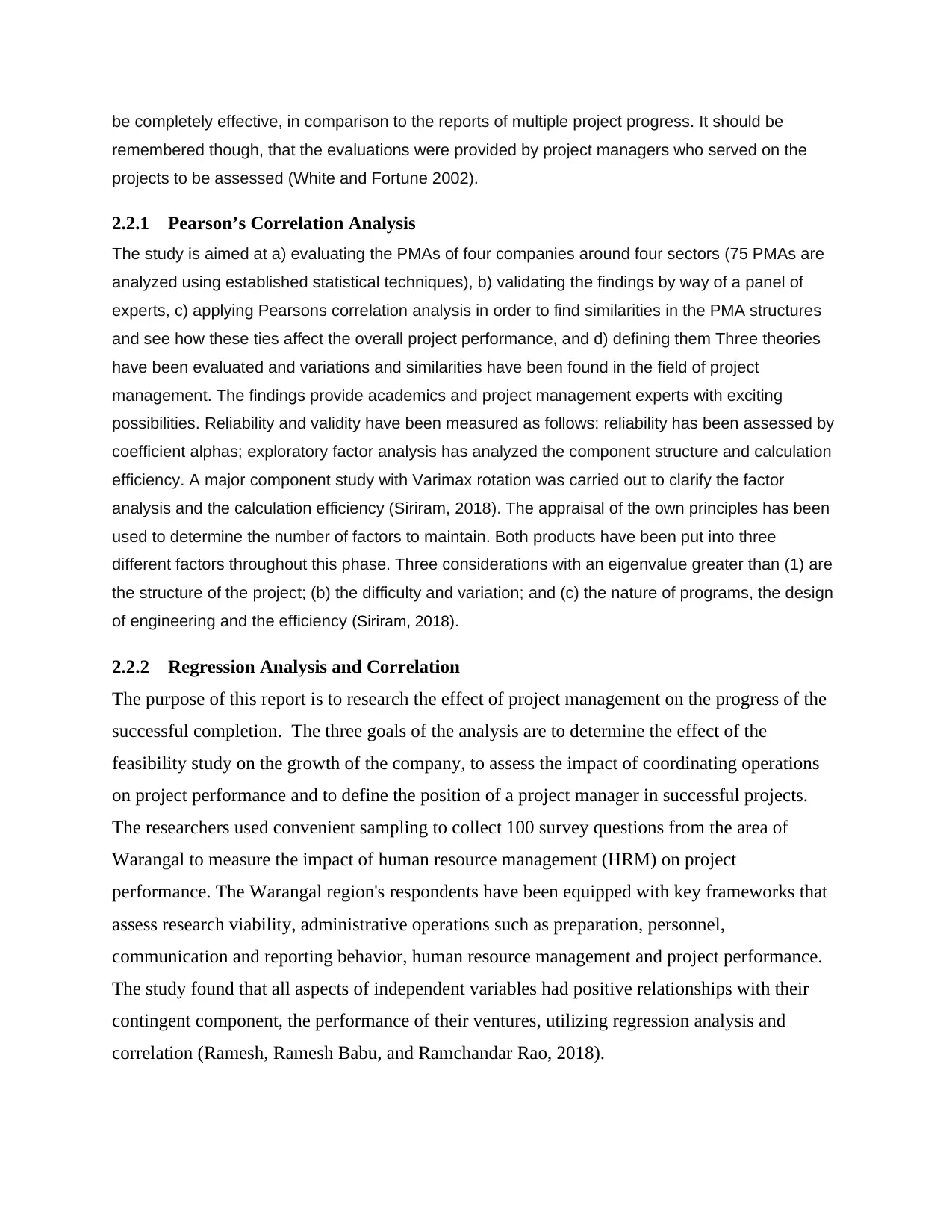
be completely effective, in comparison to the reports of multiple project progress. It should be
remembered though, that the evaluations were provided by project managers who served on the
projects to be assessed (White and Fortune 2002).
2.2.1 Pearson’s Correlation Analysis
The study is aimed at a) evaluating the PMAs of four companies around four sectors (75 PMAs are
analyzed using established statistical techniques), b) validating the findings by way of a panel of
experts, c) applying Pearsons correlation analysis in order to find similarities in the PMA structures
and see how these ties affect the overall project performance, and d) defining them Three theories
have been evaluated and variations and similarities have been found in the field of project
management. The findings provide academics and project management experts with exciting
possibilities. Reliability and validity have been measured as follows: reliability has been assessed by
coefficient alphas; exploratory factor analysis has analyzed the component structure and calculation
efficiency. A major component study with Varimax rotation was carried out to clarify the factor
analysis and the calculation efficiency (Siriram, 2018). The appraisal of the own principles has been
used to determine the number of factors to maintain. Both products have been put into three
different factors throughout this phase. Three considerations with an eigenvalue greater than (1) are
the structure of the project; (b) the difficulty and variation; and (c) the nature of programs, the design
of engineering and the efficiency (Siriram, 2018).
2.2.2 Regression Analysis and Correlation
The purpose of this report is to research the effect of project management on the progress of the
successful completion. The three goals of the analysis are to determine the effect of the
feasibility study on the growth of the company, to assess the impact of coordinating operations
on project performance and to define the position of a project manager in successful projects.
The researchers used convenient sampling to collect 100 survey questions from the area of
Warangal to measure the impact of human resource management (HRM) on project
performance. The Warangal region's respondents have been equipped with key frameworks that
assess research viability, administrative operations such as preparation, personnel,
communication and reporting behavior, human resource management and project performance.
The study found that all aspects of independent variables had positive relationships with their
contingent component, the performance of their ventures, utilizing regression analysis and
correlation (Ramesh, Ramesh Babu, and Ramchandar Rao, 2018).
remembered though, that the evaluations were provided by project managers who served on the
projects to be assessed (White and Fortune 2002).
2.2.1 Pearson’s Correlation Analysis
The study is aimed at a) evaluating the PMAs of four companies around four sectors (75 PMAs are
analyzed using established statistical techniques), b) validating the findings by way of a panel of
experts, c) applying Pearsons correlation analysis in order to find similarities in the PMA structures
and see how these ties affect the overall project performance, and d) defining them Three theories
have been evaluated and variations and similarities have been found in the field of project
management. The findings provide academics and project management experts with exciting
possibilities. Reliability and validity have been measured as follows: reliability has been assessed by
coefficient alphas; exploratory factor analysis has analyzed the component structure and calculation
efficiency. A major component study with Varimax rotation was carried out to clarify the factor
analysis and the calculation efficiency (Siriram, 2018). The appraisal of the own principles has been
used to determine the number of factors to maintain. Both products have been put into three
different factors throughout this phase. Three considerations with an eigenvalue greater than (1) are
the structure of the project; (b) the difficulty and variation; and (c) the nature of programs, the design
of engineering and the efficiency (Siriram, 2018).
2.2.2 Regression Analysis and Correlation
The purpose of this report is to research the effect of project management on the progress of the
successful completion. The three goals of the analysis are to determine the effect of the
feasibility study on the growth of the company, to assess the impact of coordinating operations
on project performance and to define the position of a project manager in successful projects.
The researchers used convenient sampling to collect 100 survey questions from the area of
Warangal to measure the impact of human resource management (HRM) on project
performance. The Warangal region's respondents have been equipped with key frameworks that
assess research viability, administrative operations such as preparation, personnel,
communication and reporting behavior, human resource management and project performance.
The study found that all aspects of independent variables had positive relationships with their
contingent component, the performance of their ventures, utilizing regression analysis and
correlation (Ramesh, Ramesh Babu, and Ramchandar Rao, 2018).
⊘ This is a preview!⊘
Do you want full access?
Subscribe today to unlock all pages.

Trusted by 1+ million students worldwide
1 out of 16
Related Documents
Your All-in-One AI-Powered Toolkit for Academic Success.
+13062052269
info@desklib.com
Available 24*7 on WhatsApp / Email
![[object Object]](/_next/static/media/star-bottom.7253800d.svg)
Unlock your academic potential
Copyright © 2020–2025 A2Z Services. All Rights Reserved. Developed and managed by ZUCOL.





